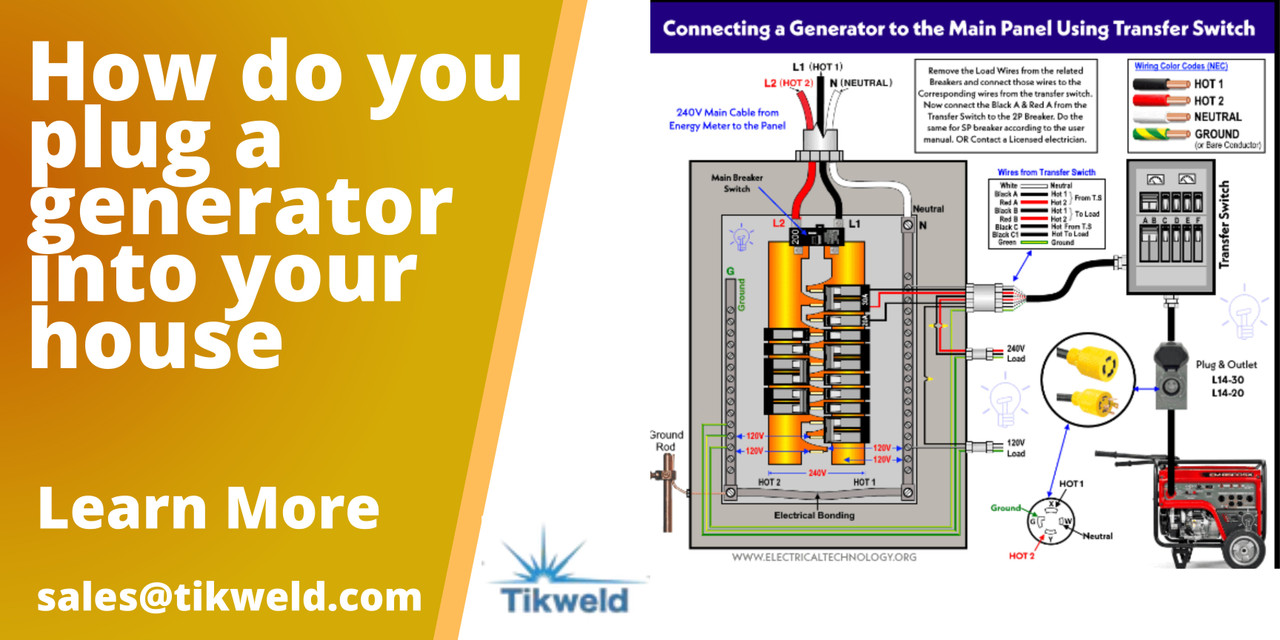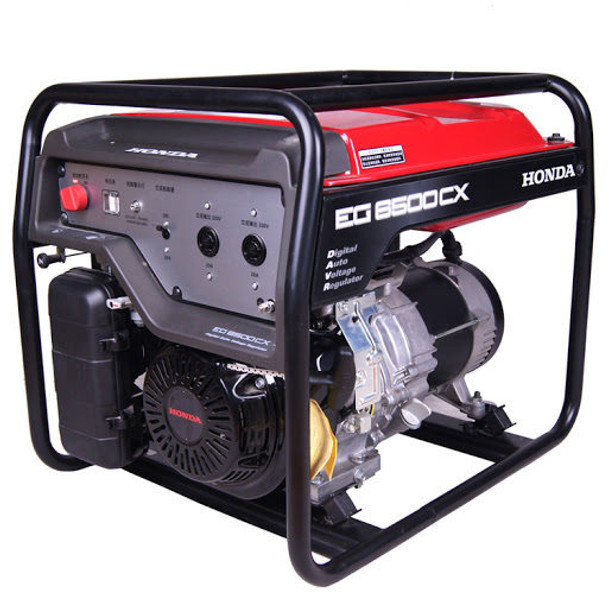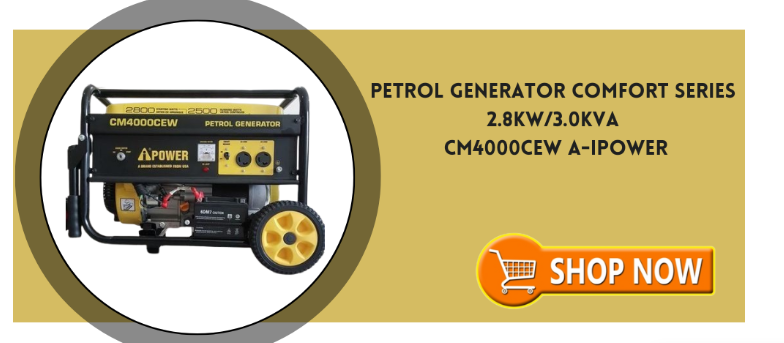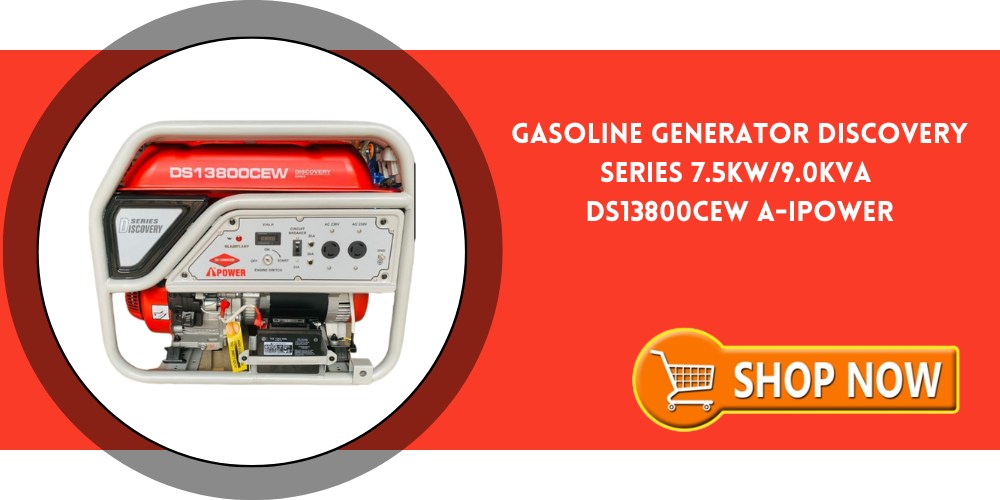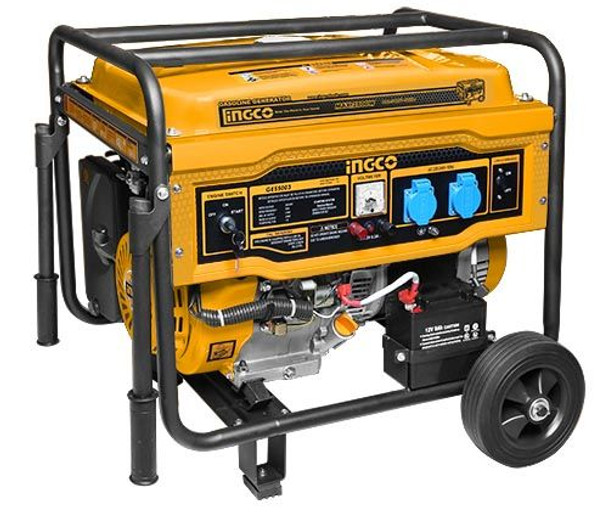How do you plug a generator into your house?
In Nigeria, where power outages are frequent, understanding how to safely and effectively connect a generator to your house is essential. Portable generators provide a reliable power source during emergencies, allowing you to keep essential appliances running. The use of electrical control device called a transfer switch is something you put next to your house's circuit breaker box.
The transfer switch's primary function is to move your home's electrical grid from the electrical utility grid to your generator which is the most recommended method that protects appliances from damage in cases of electrical surge. When the primary power source, particularly the one from the national grid, fails, a portable generator can supply emergency electrical power to a residence, making it a necessity in the home. When considering using a portable generator, only necessary home appliances, such as lighting, a TV, a refrigerator, etc., must be powered by it. Many appliances, including stoves, air conditioners, and tumble dryers, consume too much energy to be powered by a normal portable generator.
According to Nigerian Electricity Regulatory Commission (NERC), this article will show the portable generator wiring and connection diagram to the home supply and main distribution board. We will show how to wire a portable generator to a home supply without a changeover switch or transfer switches. This guide will cover two main methods of connecting a generator to your home: using extension cords for individual appliances and integrating a transfer switch to manage multiple circuits safely.
How to Connect a Portable Generator to a Home?
There are two ways to connect a portable gas generator to a house: connecting each appliance to a separate cord or utilizing a transfer switch to power a circuit panel.
1). The use of Extension and Gen Cords to Connect a Portable Generator to a House
It is ideal to always read the owner's handbook for specific instructions and safety precautions before using it. Connecting a generator to a wall outlet is never recommended; even if you use a transfer switch, ensure it is professionally installed.
Below is the pre-start checklist for the generator.
- From the generator, connect a single-gen cable to several appliances.
- To connect to appliances, run many extension wires from the outside.
- Fire up the generator.
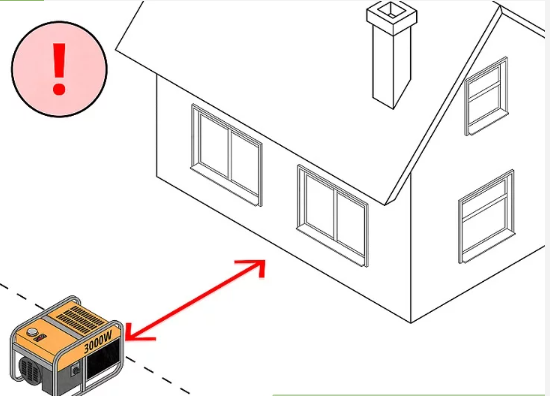
2. The use of Transfer Switches to Connect a Portable Generator to a House
- Using a gen cable, join the generator to the transfer switch.
- Outside, turn on the generator.
- Change the transfer switch's primary breakers from "Line" to "Generator" power.
- The circuits you want to power should be turned on one at a time.
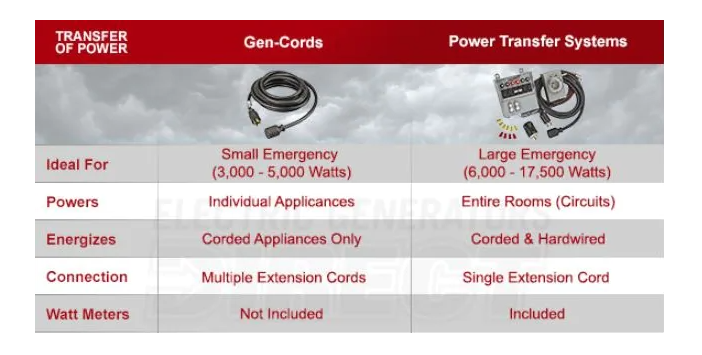
How Should I Connect My Generator using Transfer switches?
Power transfer systems are an excellent choice for connecting a big portable generator to your home in terms of power, safety, and convenience. They are equipped with everything you need to make the connection, and they can provide power to more circuits than individual appliances. Hardwired equipment like air conditioners, heaters, security systems, and lighting can all be powered by a power transfer system.
Power transfer techniques more significantly activate complete circuits than individual appliances. Hardwired equipment like air conditioners, heaters, security systems, and lighting can be powered by them.
The Use of a Transfer Switch to Connect a Generator to a House
The electrical control device also referred to as a transfer switch, is something you put next to your house's circuit breaker box. The primary function of the transfer switch's to move your home's electrical grid from the electrical utility grid to your generator. This transfer switch is also effectively used to simplify power management. The circuit breaker and the transfer switches enable you to load various outlets, rooms, or appliances on several sub-breakers. When the transfer switch is installed, there are control outlets on which sub-breaker.
Simply turning one breaker on and off will change how much power is being consumed by your generator.
In this manner, you can have your entire house hooked into the generator and use it to run specific appliances. Thanks to this, you may utilize a smaller portable generator to power your house.
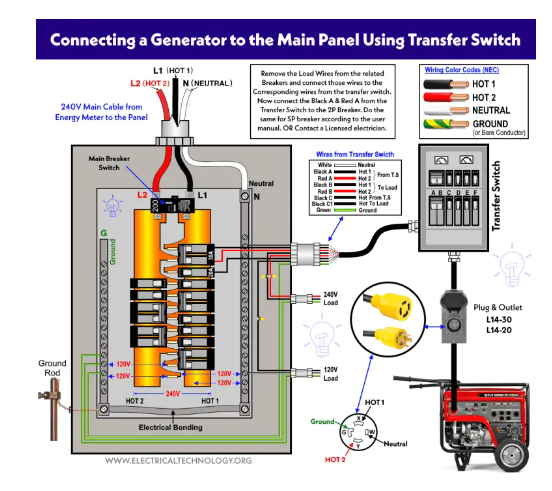
Manual vs. Universal Transfer Switches
The Transfer switches are typically offered in two different configurations: manual and universal. A typical breaker box functions similarly to a manual transfer switch. You just need to flick the correct breaker to turn on or off a certain group of appliances.
This procedure is automated using universal transfer switches. The transfer switch will automatically turn breakers on and off to keep the total power consumption below your generator's maximum rated load once you choose which outlets and appliances have precedence.
Universal transfer switches are useful because they can automatically identify when the power goes out and switch to the generator. Some switches even come with a battery backup that will let you power appliances until you can start your generator. Similar to universal switches, your home will be instantly reconnected to the electrical grid when the electricity is restored.
Installing a Transfer Switch
If you're installing a transfer switch, you'll need to change your home's circuit breaker board. This is a job for a qualified electrician. However, if you have some electrical wiring knowledge, you may be able to do the installation yourself. Most transfer switches come with detailed installation manuals.
Choosing which circuits from your main circuit board will be transferred to the transfer switch's circuits is the most crucial stage in installing a transfer switch. The size of your generator and the appliances you intend to use during a power outage will determine this. The priority levels of various appliances must be programmed into a universal transfer switch.
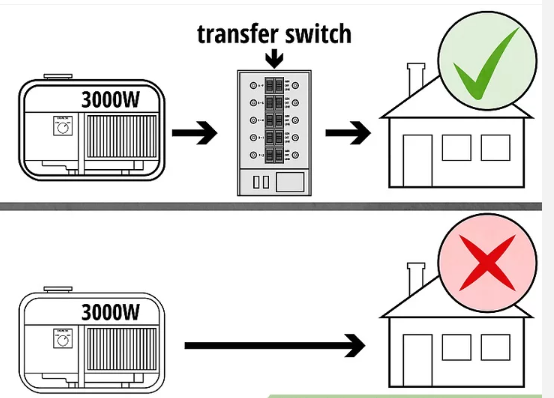
Connection Tips for using transfer switches in the home for your generator
a). The generator must be connected to the transfer switch via a generator cord to ensure a successful power transfer. This cord plugs into the outlet on your generator and the inlet on your transfer switch.
b) If you want to be prepared for a power outage in advance, keeping your generator connected to the transfer switch is best. Otherwise, ensure the generator cable is close to your generator or transfer switch, so you don't have to fumble around in the dark when the power goes out.
c). To get your generator up and to run, you'll need to start by flipping the main breaker on your transfer switch. This will ensure that the generator gets power from the generator intake rather than from the electrical utility grid. If you're using a manual transfer switch, make sure all breakers are shut off now.
d). Before turning on your generator, ensure it is in a well-ventilated area, such as outside or in a garage. Once the generator is turned on, you can go into your house and flip the breakers on your transfer switch one at a time.
e). Once the power comes back on, simply undo what you did when the power went out. To ensure that a manual transfer switch is ready to use next time there's a power outage, shut off all of the breakers.
3). How To Hook Up a Generator to Your House Without a Transfer Switch
A transfer switch is the best way to connect your home to your generator because it will help protect your generator, electronics, and wiring from damage. They can also help put out fires. If you want to travel this route, use caution and abide by local rules and regulations. It is advisable to get assistance from a certified electrician! In other ways if power must be generated without the transfer switch kindly use the guideline s below;
Step 1: Invest in an interlock kit to safely and correctly turn off the main power before turning on the generator power. This will ensure that your generator is used correctly and helps prevent accidents.
- A generator can be connected to your home without a transfer switch by using an interlock kit. This prevents the main breaker from being closed before the generator powers the box. With this in place, you never have to worry about the generator accidentally back feeding into your utility line.
- Ensure your choice of generator is the right size and model for your service box. Try as much as possible to Purchase the EXACT match, if possible.
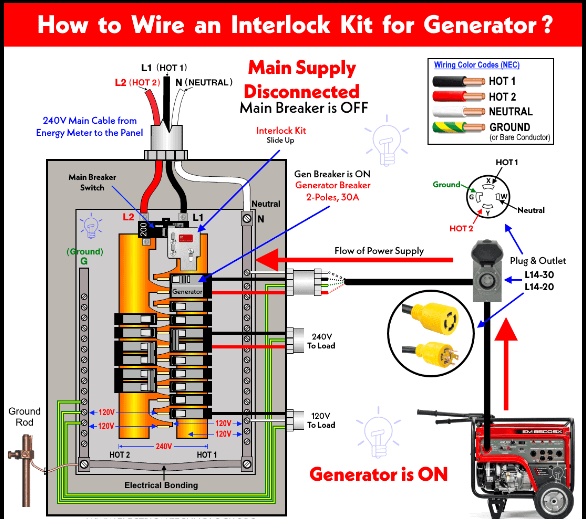
Step 2: Purchase a circuit breaker to allow power from your generator to enter your box.
When you purchase a generator, it is important to consider how much electricity it will produce. A suitable amperage 220/240-volt breaker can usually be found for your generator.
Step 3: Before using your generator, purchase the necessary cables, plugs, and tools. Depending on your situation, purchasing a 240-volt extension cable with the appropriate amperage for your generator makes sense. After that, choose a location for the exterior receptacle of your generator and purchase a suitable outside generator plug that is waterproof. Then, put the outside generator plug on the outside of your house.
Remember, electricity is no joke! Working with electricity can be dangerous, so it's important to have the right equipment. In addition to the standard electrical gear (screwdrivers, pliers, wrenches, etc.), ensure you have a decent pair of work gloves and safety glasses.
Step 4: After you've installed your outside generator plug, you'll need to connect it to a power box. First, choose a location for the exterior receptacle of your generator. Then, purchase the proper wire and outdoor generator plug to connect to your power box. Finally, have an electrician use the circuit breaker to connect your outside plug to your power box.
Step 5: Install the Interlock Kit
- The interlock kit should be installed on your panel, then finished. This will stop your generator from being connected simultaneously to your main electricity.
Useful Tips to plug a generator into your house 2023
1).Determine the essential appliances in the home you cannot do without.
A petrol-driven generator with a power output of about 3500 watts will be sufficient to run appliances like lights, a television, fans, and a fridge or freezer. The power output is usually written on the body of the generator. It refers to the power the generator can deliver for an average of 12 hours before refueling.
2).List the appliances and electrical devices you plan to use
When looking for the right choice of generators consider the type of appliance to use on it and then look at their wattage or power requirement.
A typical example of wattage usage would be a microwave which uses 1500 watts as opposed to a whole circuit of lights with CFC bulbs that may only require 150 watts. Another example would be a refrigerator that uses 1200-1500 watts but has a starting capacitor that increases wattage momentarily when the compressor starts. And lastly, televisions use less than 1000 watts depending on the type and size; a small room fan may use about 500 watts.
3).Choose a wiring system.
Several different wiring systems can be used to connect a generator to a home. The main two are discussed here. Contact your local Department of Labor and Industries, Planning Department, or Power Company to find out what is legal in your area. Do not consult the internet to determine which legal system is legal. Many people are unqualified to offer advice doing just that, and the law can vary significantly between countries, states, and even cities.
4).Consider an interlock kit.
These are fairly simple to install and are the cheapest option. However, they are illegal in many areas and can be very unsafe. They must be installed correctly. The safe installation also requires that you have several extra spaces in your existing breaker box or that you install a new one, which must be done professionally. It is also a strict requirement to get a kit approved for your specific breaker box (the same company should make it).
5).Consider a manual transfer switch.
This slightly more expensive piece of equipment will require a professional installation. However, it is the only guaranteed legal option and is the safest. This will help keep you from accidentally electrocuting someone else or even yourself.
6).Install an inlet box hookup.
This hookup will go on the outside of your house and will have a recessed male connector (prongs that stick out rather than holes you plug into). It will connect to whichever panel system you installed inside your house. A professional should perform the installation to keep you safe and ensure your system remains up to code. Suppose you do not have this done by a professional. In that case, your insurance may be unable to cover your home, the city you live in could enforce a heavy fine, and you are very likely to hurt either yourself or someone else (in a hospital-if-you're-lucky kind of way).
7).Keep your family safe!
You will find a lot of advice and instructions offered on the internet that is unsafe and put you at risk for injury, electrocution, or serious house fire. Always check with your city specialists before doing anything that will put you or your family at risk. Some common Do Nots include:
Without an approved transfer switch, do not connect your generator directly to your breaker box.
Do not connect your generator to a washing machine or dryer outlet.
8).Get your setup inspected.
This is especially important if you do not have experience with electrical work. You want to be sure that your family stays safe and, in the event of a fire, that your insurance company cannot dispute your claim because of "faulty wiring."
Safety Considerations and Local Regulations
- Safety First: Always prioritize safety when operating portable generators and transfer switches. Ensure your generator is placed outdoors, away from windows and doors to prevent exhaust fumes from entering the house.
- Local Regulations: Before installation, check with your local Department of Labor or Electricity provider for any specific regulations regarding generator connections in your area. Adhering to these regulations can prevent legal issues and ensure your setup is compliant with safety standards.
- Proper Usage: Only use appliances essential during an outage to avoid overloading your generator. High-wattage appliances like stoves and air conditioners should be used sparingly, if at all, depending on your generator’s capacity.
Alternative Connection Methods
For those needing a temporary solution during an unexpected outage, using properly rated extension cords can be a temporary measure. However, always prioritize the installation of a transfer switch for long-term safety and convenience.
By understanding these methods and adhering to safety guidelines, you can ensure that your home remains powered during outages without risking harm to yourself or your property. For more comprehensive solutions and professional installation services, consider reaching out to experts at Tikweld, who can provide both products and skilled services to meet your emergency power needs.
Connecting a generator to your house provides a reliable power source during outages, ensuring your essential appliances remain operational and your comfort is maintained. While the use of extension cords offers a quick fix, installing a transfer switch provides a safer, more reliable solution. It's essential to comply with local regulations and opt for professional installation to ensure safety and effectiveness.
For those residing in Nigeria and considering the installation of a generator, Tikweld offers a wide array of services and products tailored to meet your specific needs. From helping you select the right generator to professional installation of transfer switches, Tikweld ensures you have a seamless and safe power backup solution.
Visit Tikweld to explore our range of generators and backup power solutions, and to connect with experienced professionals who can guide you through every step of the installation process, ensuring your home is prepared for any power outage scenario.
 Gasoline Generator 5.5Kw GE55003 INGCO
Gasoline Generator 5.5Kw GE55003 INGCO
Frequently Asked Questions
1. What's the difference between Cords and Power Transfer Systems
The most common query you receive during hurricane season is, "What's the difference between extension cords, generator cords, and utilizing a switch?" The solution is fairly easy. It ultimately boils down to comfort and security. Let's examine both categories and their applications.
2. Is connecting the Generator using the Extension and generator cord safe?
Extension cords are the cheapest to connect a generator. Still, they limit the utilization of a big generator to its total capacity, just like buying something and then only utilizing half of it.
The use of extension cables may be time-consuming and dangerous, particularly during a blackout or a severe storm. In reality, utilizing a wire that is the incorrect gauge, the improper length, or worn outputs users at risk for shock and fire, jeopardizing the safety of residents. A suitable extension cord will work if you're using an inverter and need to power a few items, such as a refrigerator and some lights.
Generator Cords are the best option to spend money on a Gen-Cord if you're using a mid-sized generator and feel secure plugging in appliances during a storm but still want to utilize cables.
Simply connect the gen cable to the generator's 20- or 30-amp outlet. The other end divides into several domestic outlets, where you may begin safely securing extra extension cables indoors.
3. What is the safest way to connect a generator to my house?
The safest method to connect a generator to your home is through a transfer switch. This device ensures that the generator does not back-feed electricity into the main utility grid, which can be dangerous for utility workers and others. It also allows you to safely power hardwired appliances and is more convenient during prolonged outages.
4. Can I install a transfer switch by myself?
It is strongly recommended to have a transfer switch installed by a licensed electrician. Incorrect installation can lead to safety hazards and may violate local electrical codes. A professional installation ensures that the switch functions correctly and safely.
5. How do I choose the right generator for my home?
Selecting the right generator depends on the total wattage of the appliances you intend to power during an outage. Sum up the wattage of these appliances and choose a generator that can produce at least that amount. It's also wise to consider a generator with a slightly higher capacity than your immediate needs to accommodate potential future requirements.
6. Are portable generators safe to use in any weather?
Portable generators are designed to be versatile but should be operated in well-ventilated areas, protected from direct exposure to rain and snow. Using a generator under a canopy or in a well-ventilated shed can protect it from moisture while ensuring safe operation.
7. How often should I maintain my portable generator?
Regular maintenance is crucial for the longevity and reliability of your portable generator. Check the manufacturer’s guidelines for specific maintenance routines, which typically include checking oil levels, cleaning or replacing air filters, and running the generator periodically to ensure it’s ready for use when needed.
Related Article
Top 8 Generators Recommended by Professionals in Nigeria (Reviews)
What Causes Generators To Smoke
Where To Buy Generators In Nigeria
HOW DO GENERATORS PRODUCE ELECTRICITY?
ARE INVERTERS BETTER THAN GENERATORS?
Conclusion:
Power generators are a solution to the power failure we all suffer from in emergency breakdowns such as short circuits, overload, damage to electric transmission lines, substations, or other parts of the distribution system, as well as storms and other bad weather conditions, but the nees to properly plug in the generator is a necessity in maintaining safety as highlighted above the use of transfer switches are more convenient and safer than the use of cords.
In Nigeria, Manufacturers, distributors, suppliers, and companies such as Tikweld welding supplies and services provide various generators for Sale. We have a comprehensive list of generator services for all OEM fleets. To learn more about how to connect with a varied collection of Service Providers who consistently produce high-quality products, please contact Portable Generators Experts.

